Enhancing Wastewater Treatment Through Python ANN-Guided Optimization of Photocatalysis with Boron-Doped ZnO Synthesized via Mechanochemical Route
Abstract
1. Introduction
2. Materials and Methods
2.1. Materials and Reagents
2.2. Photocatalysis Experiments
2.3. Characterization Techniques
3. Results and Discussion
3.1. X-Ray Diffraction Analysis
3.2. SEM/EDX Analysis
3.3. Degradation Efficiency and Kinetics
3.4. Artificial Neural Network Modeling in Python
4. Conclusions
Author Contributions
Funding
Data Availability Statement
Acknowledgments
Conflicts of Interest
Abbreviations
| ANN | Artificial neural network |
| EDS | Energy-dispersive spectroscopy |
| SEM | Scanning electron microscopy |
| XRD | X-ray diffraction |
References
- Maswanganyi, S.; Gusain, R.; Kumar, N.; Fosso-Kankeu, E.; Waanders, F.B.; Ray, S.S. Bismuth Molybdate Nanoplates Supported on Reduced Graphene Oxide: An Effective Nanocomposite for the Removal of Naphthalene via Adsorption–Photodegradation. ACS Omega 2021, 6, 16783–16794. [Google Scholar] [CrossRef] [PubMed]
- Ahmed, S.; Rasul, M.G.; Brown, R.; Hashib, M.A. Influence of Parameters on the Heterogeneous Photocatalytic Degradation of Pesticides and Phenolic Contaminants in Wastewater: A Short Review. J. Environ. Manag. 2011, 92, 311–330. [Google Scholar] [CrossRef] [PubMed]
- Khasawneh, O.; Palaniandy, P. Photocatalytic Degradation of Pharmaceuticals Using TiO2 Based Nanocomposite Catalyst—Review. Civ. Environ. Eng. Rep. 2019, 29, 1–33. [Google Scholar] [CrossRef]
- Mirzaeifard, Z.; Shariatinia, Z.; Jourshabani, M.; Rezaei Darvishi, S.M. ZnO Photocatalyst Revisited: Effective Photocatalytic Degradation of Emerging Contaminants Using S-Doped ZnO Nanoparticles under Visible Light Radiation. Ind. Eng. Chem. Res. 2020, 59, 15894–15911. [Google Scholar] [CrossRef]
- Abdullah, F.H.; Bakar, N.H.H.A.; Bakar, M.A. Current Advancements on the Fabrication, Modification, and Industrial Application of Zinc Oxide as Photocatalyst in the Removal of Organic and Inorganic Contaminants in Aquatic Systems. J. Hazard. Mater. 2022, 424, 127416. [Google Scholar] [CrossRef]
- Gaggero, E.; Calza, P.; Cerrato, E.; Paganini, M.C. Cerium-, Europium- and Erbium-Modified ZnO and ZrO2 for Photocatalytic Water Treatment Applications: A Review. Catalysts 2021, 11, 1520. [Google Scholar] [CrossRef]
- Ghrib, T.; Massoudi, I.; Al-Otaibi, A.L.; Al-Malki, A.; Kharma, A.; Al-Hashem, E.; Al-Ghamdi, R.A.; Al-Zuraie, R.A. Effects of Terbium Doping on Structural, Optical and Photocatalytic Properties of ZnO Nanopowder Prepared by Solid-State Reaction. J. Inorg. Organomet. Polym. Mater. 2021, 31, 239–250. [Google Scholar] [CrossRef]
- Ruszkiewicz, J.A.; Pinkas, A.; Ferrer, B.; Peres, T.V.; Tsatsakis, A.; Aschner, M. Neurotoxic Effect of Active Ingredients in Sunscreen Products, a Contemporary Review. Toxicol. Rep. 2017, 4, 245–259. [Google Scholar] [CrossRef]
- Bawazeer, T.M. Facile and Novel Route for the Preparation of ZnO Nanoparticles with Different Cr Loadings for Opto-Photocatalysis Applications. Catalysts 2022, 12, 1093. [Google Scholar] [CrossRef]
- Hassan, K.; Hossain, R.; Farzana, R.; Sahajwalla, V. Microrecycled Zinc Oxide Nanoparticles (ZnO NP) Recovered from Spent Zn-C Batteries for VOC Detection Using ZnO Sensor. Anal. Chim. Acta 2021, 1165, 338563. [Google Scholar] [CrossRef]
- Porrawatkul, P.; Pimsen, R.; Kuyyogsuy, A.; Teppaya, N.; Noypha, A.; Chanthai, S.; Nuengmatcha, P. Microwave-Assisted Synthesis of Ag/ZnO Nanoparticles Using Averrhoa carambola Fruit Extract as the Reducing Agent and Their Application in Cotton Fabrics with Antibacterial and UV-Protection Properties. RSC Adv. 2022, 12, 15008–15019. [Google Scholar] [CrossRef]
- Ayeb, K.; Moussa, N.; Nsib, M.F.; Leonardi, S.G.; Neri, G. NO2 Sensing Properties of N-, F- and NF Co-Doped ZnO Nanoparticles. Mater. Sci. Eng. B 2021, 263, 114870. [Google Scholar] [CrossRef]
- Que, M.; Lin, C.; Sun, J.; Chen, L.; Sun, X.; Sun, Y. Progress in ZnO Nanosensors. Sensors 2021, 21, 5502. [Google Scholar] [CrossRef]
- Tsuzuki, T. Mechanochemical Synthesis of Metal Oxide Nanoparticles. Commun. Chem. 2021, 4, 143. [Google Scholar] [CrossRef] [PubMed]
- Shen, L.; Bao, N.; Yanagisawa, K.; Domen, K.; Gupta, A.; Grimes, C.A. Direct Synthesis of ZnO Nanoparticles by a Solution-Free Mechanochemical Reaction. Nanotechnology 2006, 17, 5117–5123. [Google Scholar] [CrossRef]
- De Oliveira, P.F.M.; Torresi, R.M.; Emmerling, F.; Camargo, P. Challenges and Opportunities in the Bottom-Up Mechanochemical Synthesis of Noble Metal Nanoparticles. J. Mater. Chem. A 2020, 8, 16114–16141. [Google Scholar] [CrossRef]
- Taha, K.K.; Mustafa, M.M.; Ahmed, H.A.M.; Talab, S. Selenium Zinc Oxide (Se/ZnO) Nanoparticles: Synthesis, Characterization, and Photocatalytic Activity. Z. Naturforsch. A 2019, 74, 1043–1056. [Google Scholar] [CrossRef]
- Do, J.-L.; Friščić, T. Mechanochemistry: A Force of Synthesis. ACS Cent. Sci. 2016, 3, 13–19. [Google Scholar] [CrossRef]
- Amrute, A.P.; De Bellis, J.; Schüth, F.; Felderhoff, M. Mechanochemical Synthesis of Catalytic Materials. Chem. Eur. J. 2021, 27, 6819–6847. [Google Scholar] [CrossRef]
- Grube, M.; Zellmer, S.; Janek, J.; Schubert, J.; Kwade, A.; Hofer, M.; Zeier, W.G.; Witt, M. Solvent-free and scalable mechanochemical synthesis of high-performance sulfide solid electrolytes. J. Energy Storage 2025, 121, 116593. [Google Scholar] [CrossRef]
- Furka, D.; Furka, S.; Naftaly, M.; Rakovský, E.; Čaplovičová, M.; Janek, M. ZnO Nanoparticles as Photodegradation Agent Controlled by Morphology and Boron Doping. Catal. Sci. Technol. 2021, 11, 2167–2185. [Google Scholar] [CrossRef]
- Wang, W.; Ai, T.; Yu, Q. Electrical and Photocatalytic Properties of Boron-Doped ZnO Nanostructure Grown on PET–ITO Flexible Substrates by Hydrothermal Method. Sci. Rep. 2017, 7, 42615. [Google Scholar] [CrossRef] [PubMed]
- Wang, X.; Blackford, M.; Prince, K.; Caruso, R.A. Preparation of Boron-Doped Porous Titania Networks Containing Gold Nanoparticles with Enhanced Visible-Light Photocatalytic Activity. ACS Appl. Mater. Interfaces 2012, 4, 476–482. [Google Scholar] [CrossRef] [PubMed]
- Eskalen, H.; Kavun, Y.; Kerli, S.; Eken, S. An Investigation of Radiation Shielding Properties of Boron Doped ZnO Thin Films. Opt. Mater. 2020, 105, 109871. [Google Scholar] [CrossRef]
- Ahmad, A.A.; Alsaad, A.M.; Al-Bataineh, Q.M.; Al-Naafa, M.A. Optical and Structural Investigations of Dip-Synthesized Boron-Doped ZnO-Seeded Platforms for ZnO Nanostructures. Appl. Phys. A 2018, 124, 458. [Google Scholar] [CrossRef]
- Naik, E.I.; Naik, H.S.B.; Swamy, B.E.K.; Viswanath, R.; Gowda, I.K.S.; Prabhakara, M.C.; Chetankumar, K. Influence of Cu Doping on ZnO Nanoparticles for Improved Structural, Optical, Electrochemical Properties and Their Applications in Efficient Detection of Latent Fingerprints. Chem. Data Collect. 2021, 33, 100671. [Google Scholar] [CrossRef]
- Qi, K.; Cheng, B.; Yu, J.; Ho, W. Review on the Improvement of the Photocatalytic and Antibacterial Activities of ZnO. J. Alloys Compd. 2017, 727, 792–820. [Google Scholar] [CrossRef]
- Kumar, V.; Singh, R.; Purohit, L.; Mehra, R. Structural, Transport and Optical Properties of Boron-Doped Zinc Oxide Nanocrystalline. J. Mater. Sci. Technol. 2011, 27, 481–488. [Google Scholar] [CrossRef]
- Chen, X.; Xu, B.; Xue, J.; Zhao, Y.; Wei, C.; Sun, J.; Wang, Y.; Zhang, X.; Geng, X. Boron-Doped Zinc Oxide Thin Films for Large-Area Solar Cells Grown by Metal Organic Chemical Vapor Deposition. Thin Solid Films 2007, 515, 3753–3759. [Google Scholar] [CrossRef]
- Senol, S.D.; Ozturk, O.; Terzioğlu, C. Effect of Boron Doping on the Structural, Optical and Electrical Properties of ZnO Nanoparticles Produced by the Hydrothermal Method. Ceram. Int. 2015, 41, 11194–11201. [Google Scholar] [CrossRef]
- Zhang, J.; Que, W.; Yuan, Y.; Zhong, P.; Liao, Y. Preparation of Al-Doped ZnO Nanocrystalline Aggregates with Enhanced Performance for Dye Adsorption. Sci. China Phys. Mech. Astron. 2012, 55, 1198–1202. [Google Scholar] [CrossRef]
- Pardeshi, S.K.; Patil, A.B. Effect of Morphology and Crystallite Size on Solar Photocatalytic Activity of Zinc Oxide Synthesized by Solution-Free Mechanochemical Method. J. Mol. Catal. A Chem. 2009, 308, 32–40. [Google Scholar] [CrossRef]
- Ahmed, A.Z.; Islam, M.M.; ul Islam, M.M.; Masum, S.M.; Islam, R.; Molla, M.A.I. Fabrication and Characterization of B/Sn-Doped ZnO Nanoparticles via Mechanochemical Method for Photocatalytic Degradation of Rhodamine B. Inorg. Nano-Met. Chem. 2020, 51, 1369–1378. [Google Scholar] [CrossRef]
- Savitha, D.; Latha, H.K.E.; Lalithamba, H.S.; Mala, S.; Jeppu, Y.V. Structural, Optical and Electrical Properties of Undoped and Doped (Al, Al + Mn) ZnO Nanoparticles Synthesised by Green Combustion Method Using Terminalia catappa Seed Extract. Mater. Today Proc. 2022, 60, 988–997. [Google Scholar] [CrossRef]
- Caglar, Y.; Ilican, S.; Caglar, M. FESEM, XRD and DRS Studies of Electrochemically Deposited Boron Doped ZnO Films. Mater. Sci.-Pol. 2018, 36, 824–829. [Google Scholar] [CrossRef][Green Version]
- Saadi, H.; Benzarti, Z.; Mourad, S.; Sanguino, P.; Hadouch, Y.; Mezzane, D.; Abdelmoula, N.; Khemakhem, H. Electrical Conductivity Improvement of (Fe + Al) Co-Doped ZnO Nanoparticles for Optoelectronic Applications. J. Mater. Sci. Mater. Electron. 2022, 33, 8065–8085. [Google Scholar] [CrossRef]
- Shannon, R.D. Revised Effective Ionic Radii and Systematic Studies of Interatomic Distances in Halides and Chalcogenides. Acta Crystallogr. Sect. A 1976, 32, 751–767. [Google Scholar] [CrossRef]
- Tsay, C.-Y.; Hsu, W.-T. Sol–Gel Derived Undoped and Boron-Doped ZnO Semiconductor Thin Films: Preparation and Characterization. Ceram. Int. 2013, 39, 7425–7432. [Google Scholar] [CrossRef]
- Gherab, K.; Al-Douri, Y.; Hashim, U.; Ameri, M.; Bouhemadou, A.; Batoo, K.M.; Adil, S.F.; Khan, M.; Raslan, E.H. Fabrication and characterizations of Al nanoparticles doped ZnO nanostructures-based integrated electrochemical biosensor. J. Mater. Res. Technol. 2019, 9, 857–867. [Google Scholar] [CrossRef]
- Patil, A.B.; Patil, K.R.; Pardeshi, S.K. Ecofriendly synthesis and solar photocatalytic activity of S-doped ZnO. J. Hazard. Mater. 2010, 183, 315–323. [Google Scholar] [CrossRef]
- Naik, E.I.; Naik, H.S.B.; Viswanath, R.; Kirthan, B.R.; Prabhakara, M.C. Effect of Zirconium Doping on the Structural, Optical, Electrochemical and Antibacterial Properties of ZnO Nanoparticles Prepared by Sol-Gel Method. Chem. Data Collect. 2020, 29, 100505. [Google Scholar] [CrossRef]
- Bomila, R.; Suresh, S.; Srinivasan, S. Synthesis, Characterization and Comparative Studies of Dual Doped ZnO Nanoparticles for Photocatalytic Applications. J. Mater. Sci. Mater. Electron. 2019, 30, 582–592. [Google Scholar] [CrossRef]
- Raji, P.; Kumar, K.B. Investigation of Ti Doping on the Structural, Optical, and Magnetic Properties of ZnO Nanoparticles. J. Mater. Sci. Mater. Electron. 2021, 32, 11751–11762. [Google Scholar] [CrossRef]
- Ahmed, S.A. Room-Temperature Ferromagnetism in Co-, Cr-, and V-Doped ZnO Diluted Magnetic Semiconductor. Appl. Phys. A 2017, 123, 440. [Google Scholar] [CrossRef]
- Naik, E.I.; Naik, H.S.B.; Sarvajith, M.S.; Pradeepa, E. Co-Precipitation Synthesis of Cobalt Doped ZnO Nanoparticles: Characterization and Their Applications for Biosensing and Antibacterial Studies. Inorg. Chem. Commun. 2021, 130, 108678. [Google Scholar] [CrossRef]
- Luque-Morales, P.A.; Lopez-Peraza, A.; Nava-Olivas, O.J.; Amaya-Parra, G.; Baez-Lopez, Y.A.; Orozco-Carmona, V.M.; Garrafa-Galvez, H.E.; Chinchillas-Chinchillas, M.d.J. ZnO Semiconductor Nanoparticles and Their Application in Photocatalytic Degradation of Various Organic Dyes. Materials 2021, 14, 7537. [Google Scholar] [CrossRef]
- Farhat, S.; Rekaby, M.; Awad, R. Synthesis and Characterization of Er-Doped Nano ZnO Samples. J. Supercond. Nov. Magn. 2018, 31, 3051–3061. [Google Scholar] [CrossRef]
- Zhao, D.; Yu, Y.; Cao, C.; Wang, J.; Wang, E.; Cao, Y. The Existing States of Doped B3+ Ions on the B Doped TiO2. Appl. Surf. Sci. 2015, 345, 67–71. [Google Scholar] [CrossRef]
- Naik, E.I.; Naik, H.S.B.; Viswanath, R.; Gowda, I.K.S.; Prabhakara, M.C. Bright Red Luminescence Emission of Macroporous Honeycomb-Like Eu3+ Ion-Doped ZnO Nanoparticles Developed by Gel-Combustion Technique. SN Appl. Sci. 2020, 2, 863. [Google Scholar] [CrossRef]
- Mesaros, A.; Perhaita, I.; Toloman, D.; Mos, R.B.; Nasui, M.; Vasile, B.S.; Biris, A.; Petrisor, T.; Pana, O.; Surdu, V.A.A. Valence States Approach for Luminescence Enhancement by Low Dopant Concentration in Eu-Doped ZnO Nanoparticles. J. Mater. Sci. 2015, 50, 6075–6086. [Google Scholar] [CrossRef]
- Okeke, I.S.; Agwu, K.K.; Ubachukwu, A.A.; Madiba, I.G.; Maaza, M.; Whyte, G.M.; Ezema, F.I. Impact of Particle Size and Surface Defects on Antibacterial and Photocatalytic Activities of Undoped and Mg-Doped ZnO Nanoparticles, Biosynthesized Using One-Step Simple Process. Vacuum 2021, 187, 110110. [Google Scholar] [CrossRef]
- Jaballah, S.; Dahman, H.; Ghiloufi, I.; Neri, G.; El Mir, L. Facile Synthesis of Al–Mg Co-Doped ZnO Nanoparticles and Their High Hydrogen Sensing Performances. Int. J. Hydrogen Energy 2020, 45, 34268–34280. [Google Scholar] [CrossRef]
- Kumar, S.; Asokan, K.; Chatterjee, S.; Ghosh, A.K.; Singh, R.K.; Kanjilal, D. Investigations on Structural and Optical Properties of ZnO and ZnO:Co Nanoparticles under Dense Electronic Excitations. RSC Adv. 2014, 4, 62123–62131. [Google Scholar] [CrossRef]
- Abdulrahman, N.A.; Haddad, N.I.A. Braggs, Scherre, Williamson–Hall and Ssp Analyses to Estimate the Variation of Crystallites Sizes and Lattice Constants for ZnO Nanoparticles Synthesized at Different Temperatures. NeuroQuantology 2020, 18, 53–63. [Google Scholar] [CrossRef]
- Vijayaprasath, G.; Murugan, R.; Asaithambi, S.; Sakthivel, P.; Mahalingam, T.; Hayakawa, Y.; Ravi, G. Structural and Magnetic Behavior of Ni/Mn Co-Doped ZnO Nanoparticles Prepared by Co-Precipitation Method. Ceram. Int. 2016, 42, 2836–2845. [Google Scholar] [CrossRef]
- Zhang, X.; Wang, L.; Qin, J.; Shen, X.; Yu, R.; Limpanart, S.; Ma, M.; Liu, R.; Hao, R. Carbon-Doped ZnO Nanostructures: Facile Synthesis and Visible Light Photocatalytic Applications. J. Phys. Chem. C 2015, 119, 20544–20554. [Google Scholar] [CrossRef]
- Devi, P.G.; Velu, A.S. Synthesis, Structural and Optical Properties of Pure ZnO and Co Doped ZnO Nanoparticles Prepared by the Co-Precipitation Method. J. Theor. Appl. Phys. 2016, 10, 233–240. [Google Scholar] [CrossRef]
- Ashok Kumawat, A.; Chattopadhyay, S.; Misra, K.P.; Misra, R.D.K.; Kumari, P. Micro-Strain Governed Photoluminescence Emission Intensity of Sol-Gel Spin Coated Eu Doped ZnO Thin Films. Thin Solid Films 2022, 761, 139521. [Google Scholar] [CrossRef]
- Bindu, P.; Thomas, S. Estimation of Lattice Strain in ZnO Nanoparticles: X-Ray Peak Profile Analysis. J. Theor. Appl. Phys. 2014, 8, 123–134. [Google Scholar] [CrossRef]
- Singh, J.; Singh, R.C. Enhancement of Optical, Dielectric and Transport Properties of (Sm, V) Co-Doped ZnO System and Structure-Property Correlations. Ceram. Int. 2021, 47, 10611–10627. [Google Scholar] [CrossRef]
- Saravanakumar, K.; Sakthivel, P.; Sankaranarayanan, R.K. Influence of Sn4+ Ion on Band Gap Tailoring, Optical, Structural and Dielectric Behaviors of ZnO Nanoparticles. Spectrochim. Acta Part A 2021, 267, 120487. [Google Scholar] [CrossRef] [PubMed]
- Moon, S.M.; Heo, J.E.; Jeon, J.; Eom, T.; Jang, D.; Her, K.; Shim, B.S. High Crystallinity of Tunicate Cellulose Nanofibers for High-Performance Engineering Films. Carbohydr. Polym. 2021, 254, 117470. [Google Scholar] [CrossRef]
- Liu, Y.; Zhang, Y.; Lim, K.H.; Ibáñez, M.; Ortega, S.; Li, M.; Cabot, A. High Thermoelectric Performance in Crystallographically Textured n-Type Bi2Te3−xSex Produced from Asymmetric Colloidal Nanocrystals. ACS Nano 2018, 12, 7174–7184. [Google Scholar] [CrossRef] [PubMed]
- Kumar, P.; Pandey, P.C.; Singh, B.K.; Pal, B.N. Correlation between Structural, Optical and Magnetic Properties of Mn-Doped ZnO. Appl. Phys. A 2016, 122, 740. [Google Scholar] [CrossRef]
- Kamble, V.S.; Desai, N.K.; Patil, V.B.; Navale, Y.H.; Salunkhe, S.T. Enhanced NO2 Gas Sensing Performance of Ni-Doped ZnO Nanostructures. J. Mater. Sci. Mater. Electron. 2021, 32, 2219–2233. [Google Scholar] [CrossRef]
- Addonizio, M.L.; Diletto, C. Doping Influence on Intrinsic Stress and Carrier Mobility of LP-MOCVD Deposited Zn0:B Thin Films. Sol. Energy Mater. Sol. Cells 2008, 92, 1488–1494. [Google Scholar] [CrossRef]
- Moulahi, A.; Sediri, F. Pencil-Like Zinc Oxide Micro/Nano-Scale Structures: Hydrothermal Synthesis, Optical and Photocatalytic Properties. Mater. Res. Bull. 2013, 48, 3723–3728. [Google Scholar] [CrossRef]
- Shabna, S.; Biju, C.S.; Singh, C.J.C.; Dhas, S.D.S.J.; Jeyakumar, S.C. An Overview of Prominent Factors Influencing the Photocatalytic Degradation of Cationic Crystal Violet Dye Employing Diverse Nanostructured Materials. J. Chem. Technol. Biotechnol. 2024, 99, 1027–1055. [Google Scholar] [CrossRef]
- Wang, S.; Zhang, X.; Li, S.; Fang, Y.; Pan, L.; Zou, J.-J. C-doped ZnO ball-in-ball hollow microspheres for efficient photocatalytic and photoelectrochemical applications. J. Hazard. Mater. 2017, 331, 235–245. [Google Scholar] [CrossRef]
- Sharma, V.; Sharma, J.K.; Kansay, V.; Sharma, V.D.; Sharma, A.; Kumar, S.; Sharma, A.K.; Bera, M.K. The Effect of Calcination Temperatures on the Structural and Optical Properties of Zinc Oxide Nanoparticles and Their Influence on the Photocatalytic Degradation of Leather Dye. Chem. Phys. Impact 2023, 6, 100196. [Google Scholar] [CrossRef]
- Ebrahimi, R.; Maleki, A.; Zandsalimi, Y.; Ghanbari, R.; Shahmoradi, B.; Rezaee, R.; Safari, M.; Joo, S.; Daraei, H.; Puttaiah, S.; et al. Photocatalytic Degradation of Organic Dyes Using WO3-Doped ZnO Nanoparticles Fixed on a Glass Surface in Aqueous Solution. J. Ind. Eng. Chem. 2019, 73, 297–305. [Google Scholar] [CrossRef]
- Jiang, L.; Ni, S.; Liu, G.; Xu, X. Photocatalytic hydrogen production over Aurivillius compound Bi3TiNbO9 and its modifications by Cr/Nb co-doping. Appl. Catal. B Environ. 2017, 217, 342–352. [Google Scholar] [CrossRef]
- Moafi, H.F.; Zanjanchi, M.A.; Shojaie, A.F. Tungsten-doped ZnO nanocomposite: Synthesis, characterization, and highly active photocatalyst toward dye photodegradation. Mater. Chem. Phys. 2013, 139, 856–864. [Google Scholar] [CrossRef]
- Agale, P.; Salve, V.; Mardikar, S.; Patange, S.; More, P. Synthesis and characterization of hierarchical Sr-doped ZnO hexagonal nanodisks as an efficient photocatalyst for the degradation of methylene blue dye under sunlight irradiation. Appl. Surf. Sci. 2024, 672, 160795. [Google Scholar] [CrossRef]
- Alshammari, A.S.; Bagabas, A.; Chen, X.; Kramer, D.; Chi, L.; Alromaeh, A.; Jiang, Z. Visible-light photocatalysis on C-doped ZnO derived from polymer-assisted pyrolysis. RSC Adv. 2015, 5, 27690–27698. [Google Scholar] [CrossRef]
- Al-Ghamdi, S.; Al-Qarni, M.; Al-Shehri, F.; Mbarki, A.; Al-Rashidi, M.; Abd-Elnaiem, A.; Rashad, M. Photocatalytic Degradation of Potassium Permanganate Using Zinc Oxide Nanoparticles. Dig. J. Nanomater. Biostruct. 2021, 16, 889–900. [Google Scholar] [CrossRef]
- Jongnavakit, P.; Amornpitoksuk, P.; Suwanboon, S.; Ndiege, N. Preparation and Photocatalytic Activity of Cu-Doped ZnO Thin Films Prepared by the Sol-Gel Method. Appl. Surf. Sci. 2012, 258, 8192–8198. [Google Scholar] [CrossRef]
- Roguai, S.; Djelloul, A. Structural, Microstructural and Photocatalytic Degradation of Methylene Blue of Zinc Oxide and Fe-Doped ZnO Nanoparticles Prepared by Simple Coprecipitation Method. Solid State Commun. 2021, 334–335, 114362. [Google Scholar] [CrossRef]
- Naz, F.; Saeed, K. Investigation of Photocatalytic Behavior of Undoped ZnO and Cr-Doped ZnO Nanoparticles for the Degradation of Dye. Inorg. Nano-Met. Chem. 2020, 51, 1–11. [Google Scholar] [CrossRef]
- Herrmann, J.-M. Heterogeneous Photocatalysis: Fundamentals and Applications to the Removal of Various Types of Aqueous Pollutants. Catal. Today 1999, 53, 115–129. [Google Scholar] [CrossRef]
- Domínguez, J.R.; González, T.; Correia, S. BDD Electrochemical Oxidation of Neonicotinoid Pesticides in Natural Surface Waters. Operational, Kinetic and Energetic Aspects. J. Environ. Manag. 2021, 298, 113538. [Google Scholar] [CrossRef]
- Bian, Y.; Sheng, Z.; Hu, L.; Zheng, G.; Ding, W. Magnetic field effect on the photocatalytic degradation of methyl orange by commercial TiO2 powder†. RSC Adv. 2021, 11, 6284–6291. [Google Scholar] [CrossRef] [PubMed]
- Rashid Al-Mamun, M.; Zaved Hossain Khan, D.M.; Hossain, K.T.; Mondal, S.; Afroza Khatun, M.; Shahinoor Islam, M. Synthesis, characterization, and photocatalytic performance of methyl orange in aqueous TiO2 suspension under UV and solar light irradiation. S. Afr. J. Chem. Eng. 2022, 40, 113–125. [Google Scholar] [CrossRef]
- Girginov, C.; Stefchev, P.; Vitanov, P.; Dikov, H. Silver Doped TiO2 Photocatalyst for Methyl Orange Degradation. J. Eng. Sci. Technol. Rev. 2012, 5, 14–17. [Google Scholar] [CrossRef]
- Wang, Y.; Liu, Y.; Fan, Y.; Dang, F.; Liu, Y.; Wang, W.; Yang, C.; Qiu, Y.; Zhou, H. Solvothermal Synthesis of ZnO Nanoparticles for Photocatalytic Degradation of Methyl Orange and p-Nitrophenol. Water 2021, 13, 3224. [Google Scholar] [CrossRef]
- Vargas, M.A.; Rivera-Muñoz, E.M.; Diosa, J.E.; Mosquera, E.E.; Rodríguez-Páez, J.E. Nanoparticles of ZnO and Mg-doped ZnO: Synthesis, characterization and efficient removal of methyl orange (MO) from aqueous solution. Ceram. Int. 2021, 47, 15668–15681. [Google Scholar] [CrossRef]
- Bhosale, A.; Kadam, J.; Gade, T.; Sonawane, K.; Garadkar, K. Efficient photodegradation of methyl orange and bactericidal activity of Ag doped ZnO nanoparticles. J. Indian Chem. Soc. 2023, 100, 100920. [Google Scholar] [CrossRef]
- Ajil, A.H.; Ibnaouf, K.H.; Cabrera, H.; Yam, F.K.; Wadi, I.A.; M Binzowaimil, A.; Zango, Z.U.; Ahmed, N.M.; Aldaghri, O. Enhancing Methyl Orange Degradation with Laser-Generated ZnO and Ce-Doped ZnO Nanoparticles. Appl. Sci. 2023, 13, 11857. [Google Scholar] [CrossRef]
- Oyewo, O.A.; Ramaila, S.; Mavuru, L.; Onwudiwe, D.C. Enhanced photocatalytic degradation of methyl orange using Sn-ZnO/GO nanocomposite. J. Photochem. Photobiol. 2022, 11, 100131. [Google Scholar] [CrossRef]
- Khataee, A.R.; Kasiri, M.B. Artificial Neural Networks Modeling of Contaminated Water Treatment Processes by Homogeneous and Heterogeneous Nanocatalysis. J. Mol. Catal. A Chem. 2010, 331, 86–100. [Google Scholar] [CrossRef]
- Zamouche, M.; Tahraoui, H.; Laggoun, Z.; Mechati, S.; Chemchmi, R.; Kanjal, M.I.; Amrane, A.; Hadadi, A.; Mouni, L. Optimization and Prediction of Stability of Emulsified Liquid Membrane (ELM): Artificial Neural Network. Processes 2023, 11, 364. [Google Scholar] [CrossRef]
- Manaswi, N. Understanding and Working with Keras. In Deep Learning with Applications Using Python; Apress: Berkeley, CA, USA, 2018; pp. 31–43. [Google Scholar] [CrossRef]
- Sumathi, D.; Alluri, K. Deploying Deep Learning Models for Various Real-Time Applications Using Keras. In Advanced Deep Learning for Engineers and Scientists; Springer: Cham, Switzerland, 2021. [Google Scholar] [CrossRef]
- Hunter, J.D. Matplotlib: A 2D Graphics Environment. Comput. Sci. Eng. 2007, 9, 90–95. [Google Scholar] [CrossRef]
- Hunt, J. Introduction to Matplotlib. In Advanced Guide to Python 3 Programming; Springer: Cham, Switzerland, 2019. [Google Scholar] [CrossRef]
- McKinney, W. Data Structures for Statistical Computing in Python. In Proceedings of the 9th Python in Science Conference, Austin, TX, USA, 28 June–3 July 2010; pp. 56–61. [Google Scholar] [CrossRef]
- Burns, H. Crowdsourced-Data Normalization with Python and Pandas. Program. Hist. 2021. [Google Scholar] [CrossRef]
- Feurer, M.; Eggensperger, K.; Falkner, S.; Lindauer, M.; Hutter, F. Auto-Sklearn 2.0: The Next Generation. arXiv 2020, arXiv:2007.04074. [Google Scholar] [CrossRef]
- Li, P. Research on Radar Signal Recognition Based on Automatic Machine Learning. Neural Comput. Appl. 2019, 32, 1959–1969. [Google Scholar] [CrossRef]
- Liu, Z.; Cui, Y.; Chan, A. Improve Generalization and Robustness of Neural Networks via Weight Scale Shifting Invariant Regularizations. arXiv 2020, arXiv:2008.02965. [Google Scholar] [CrossRef]
- Dubey, S.R.; Chakraborty, S.; Mukherjee, S.; Singh, S.K.; Chaudhuri, B.B.; Roy, S.K. diffGrad: An Optimization Method for Convolutional Neural Networks. IEEE Trans. Neural Netw. Learn. Syst. 2020, 31, 4500–4511. [Google Scholar] [CrossRef]
- Netrapalli, P. Stochastic Gradient Descent and Its Variants in Machine Learning. J. Indian Inst. Sci. 2019, 99, 201–213. [Google Scholar] [CrossRef]
- Ghojogh, B.; Crowley, M. The Theory Behind Overfitting, Cross Validation, Regularization, Bagging, and Boosting: Tutorial. arXiv 2019, arXiv:1905.12787. [Google Scholar] [CrossRef]
- Ying, X. An Overview of Overfitting and Its Solutions. J. Phys. Conf. Ser. 2019, 1168, 022022. [Google Scholar] [CrossRef]
- Fuentes, S.; Viejo, C.G.; Tongson, E.; Lipovetzky, N.; Dunshea, F.R. Biometric Physiological Responses from Dairy Cows Measured by Visible Remote Sensing Are Good Predictors of Milk Productivity and Quality Through Artificial Intelligence. Sensors 2021, 21, 6844. [Google Scholar] [CrossRef] [PubMed]
- Correndo, A.A.; Hefley, T.J.; Holzworth, D.P.; Ciampitti, I.A. Revisiting Linear Regression to Test Agreement in Continuous Predicted-Observed Datasets. Agric. Syst. 2021, 192, 103194. [Google Scholar] [CrossRef]
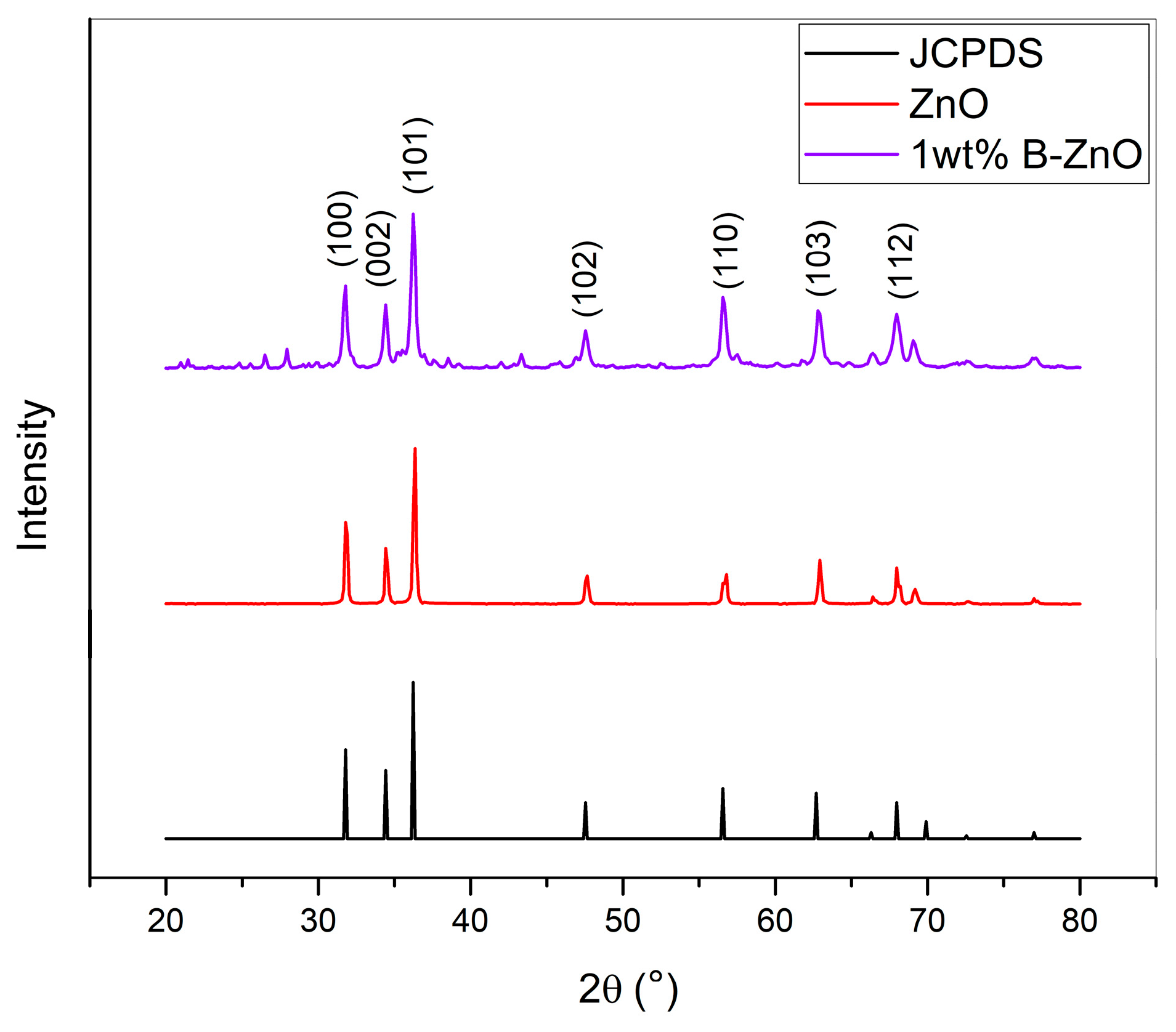
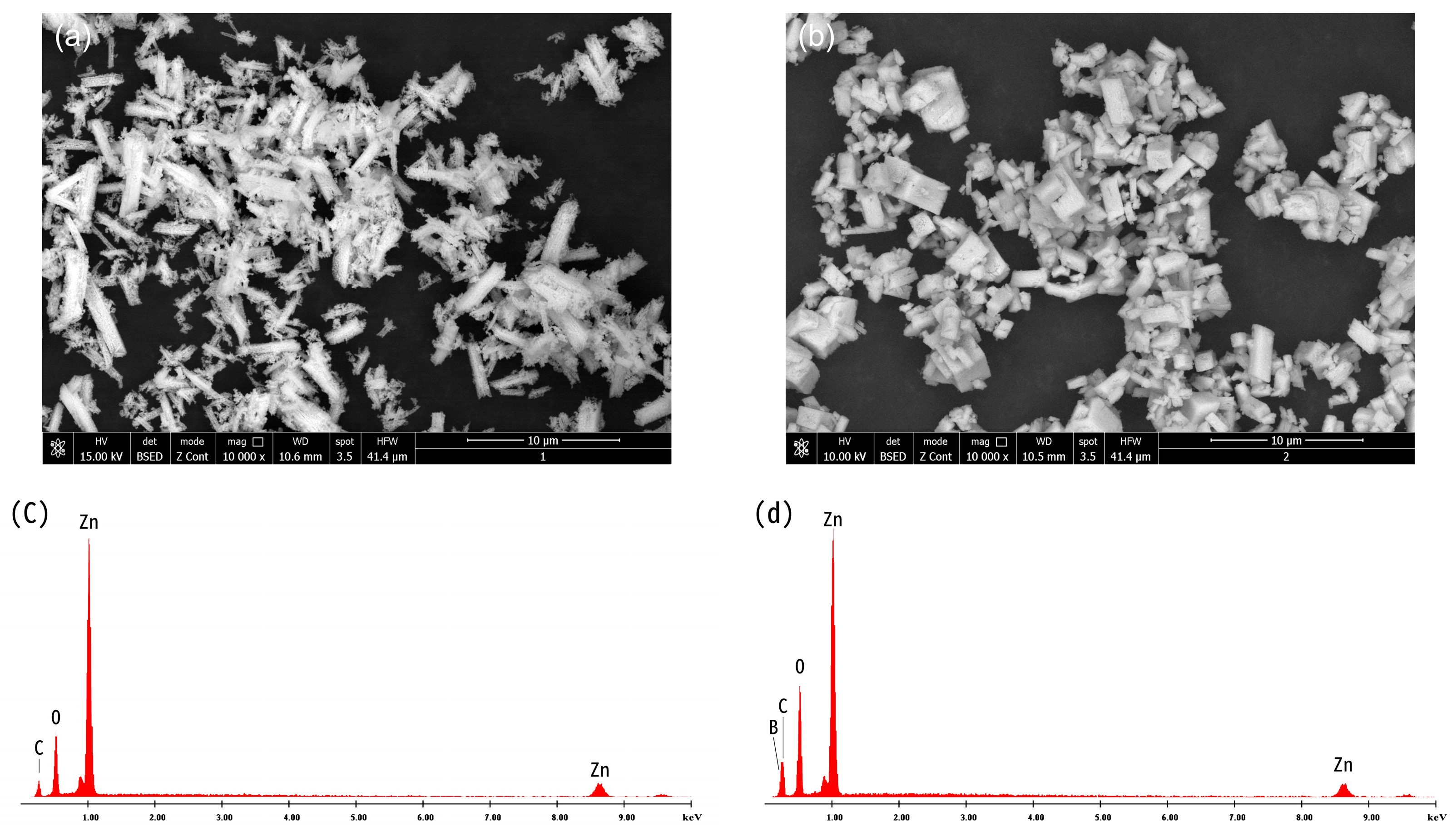
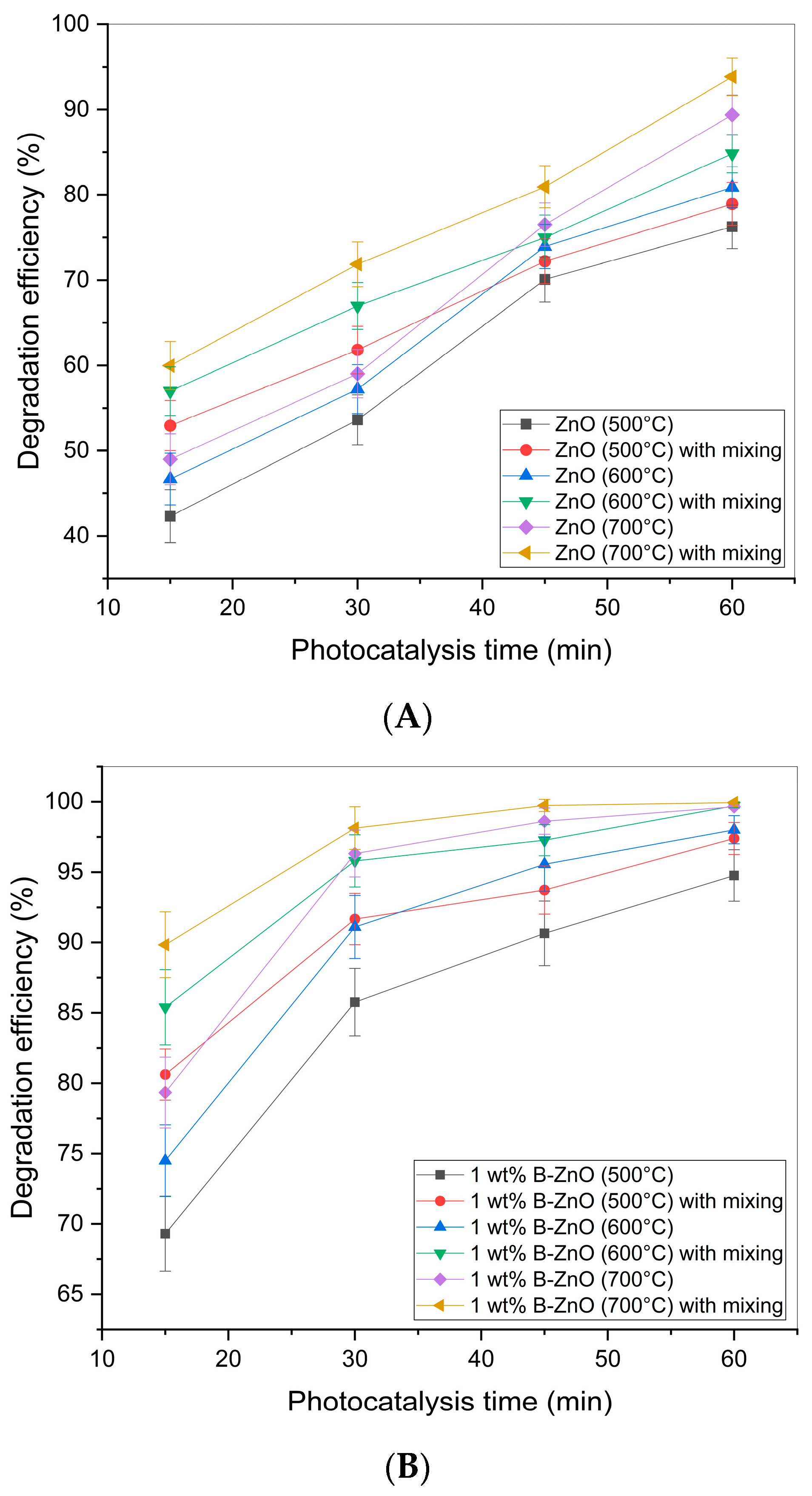
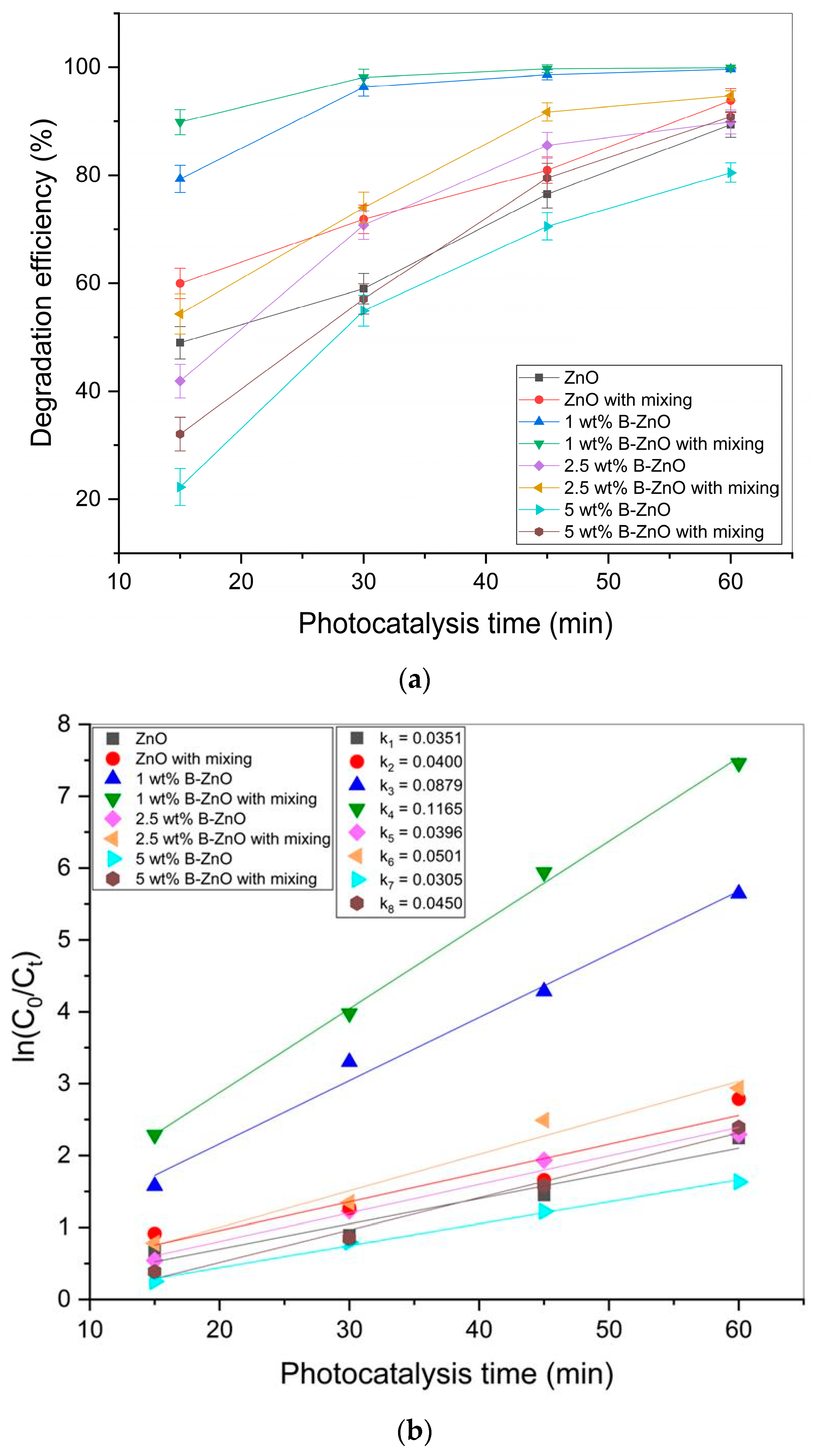


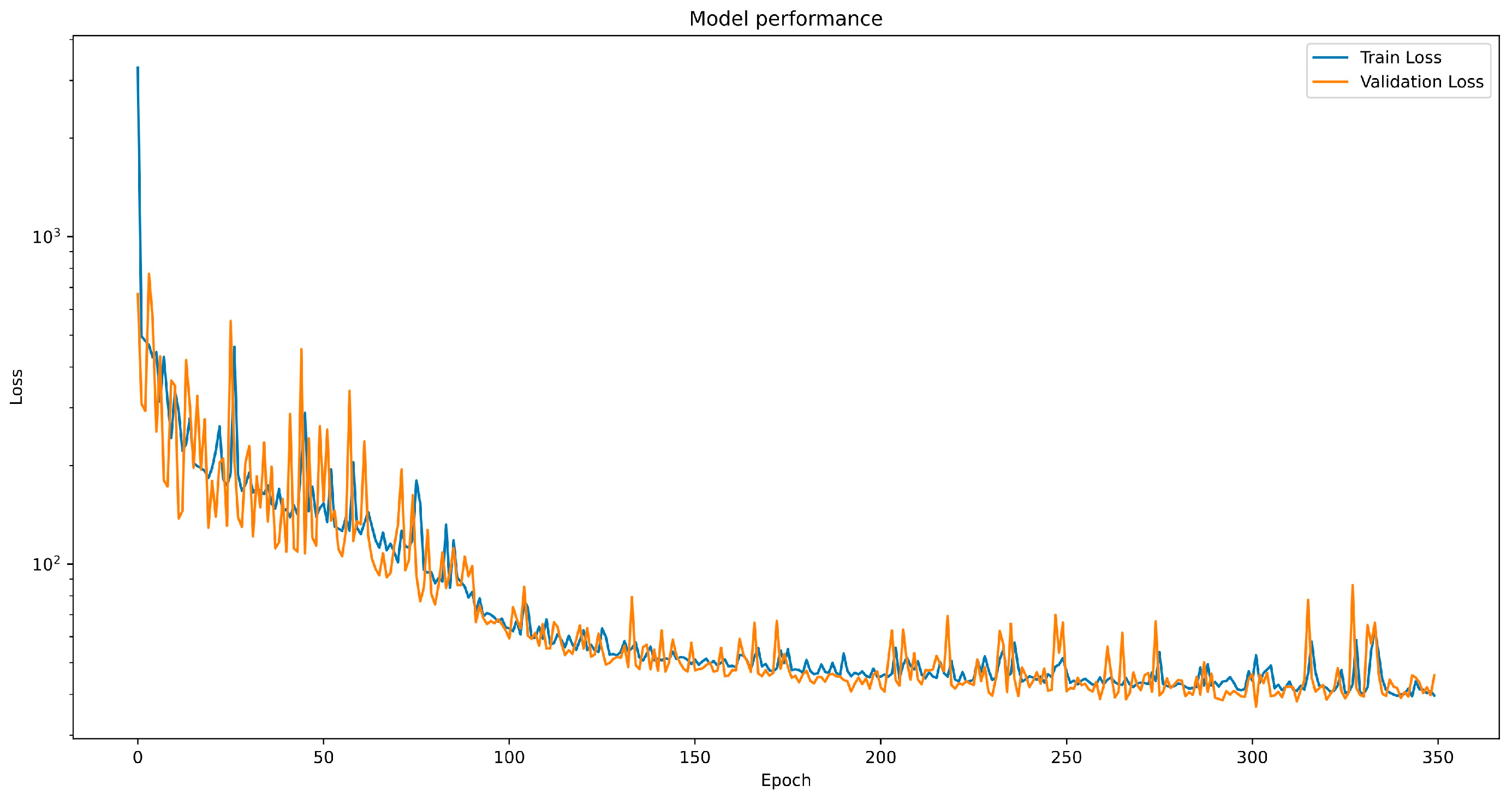
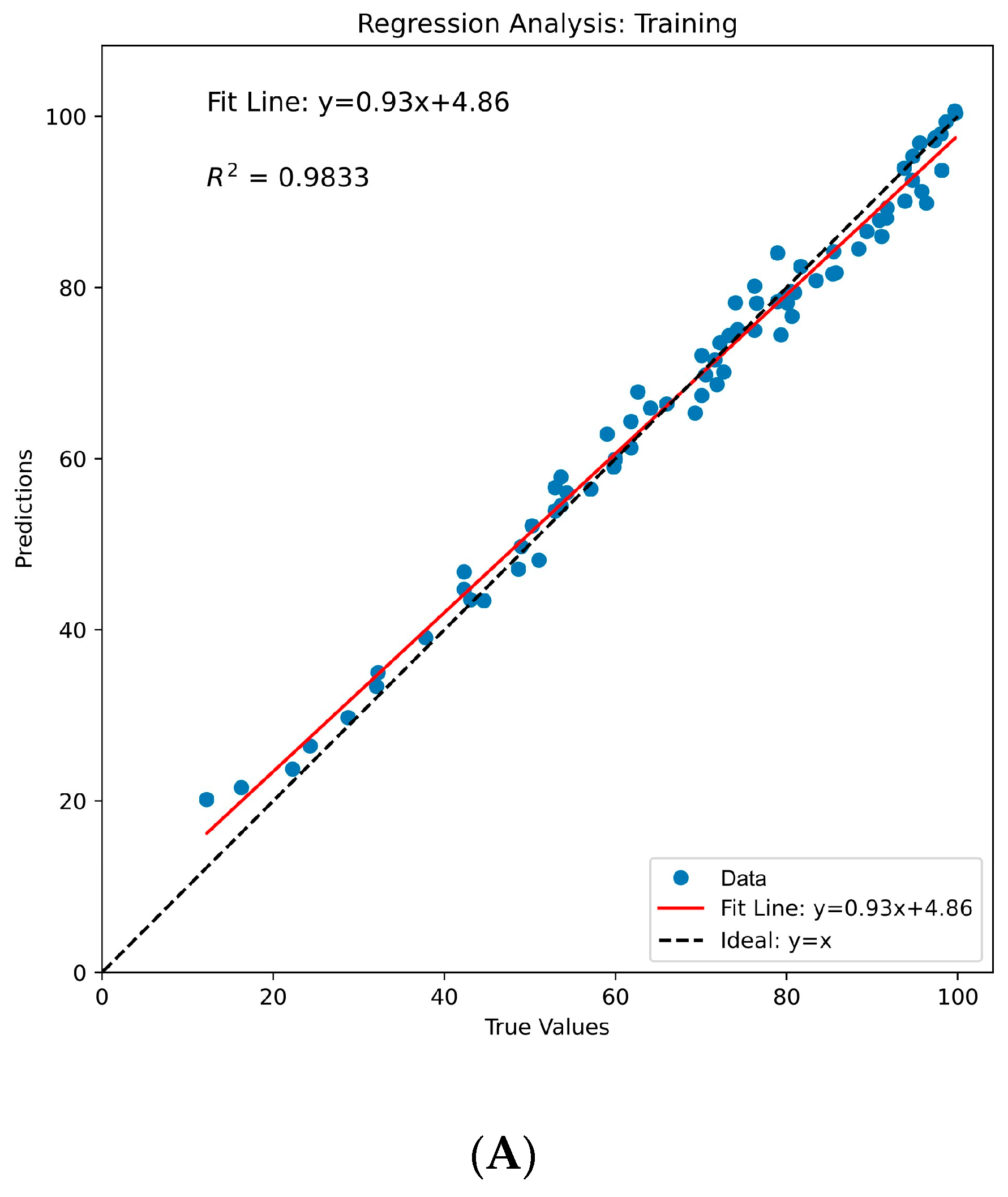


| Sample | α (Å) | c (Å) | c/α | R | D (nm) | d (nm) | V (Å3) |
|---|---|---|---|---|---|---|---|
| ZnO | 3.2427 | 5.1981 | 1.60 | 1.0187 | 45.05 | 0.2855 | 47.33 |
| 1 wt%B-ZnO | 3.2512 | 5.2077 | 1.60 | 1.0195 | 26.44 | 0.2860 | 47.67 |
| Sample | L (nm) | u | ε∙10−3 | α* | δ∙10−3 (nm−2) | APF (%) | |
| ZnO | 1.9738 | 0.3797 | 0.66 | 0.0007 | 0.4927 | 75.3945 | |
| 1 wt%B-ZnO | 1.9785 | 0.3799 | 1.14 | 0.0013 | 1.4305 | 75.4528 | |
| Experimental Data Used for Target Predictions | |||||
|---|---|---|---|---|---|
| Input 1 | Input 2 | Input 3 | Input 4 | Target (Experimental) | Target Predictions Estimated by Python Script |
| 2.5 | 0 | 600 | 45 | 85.80 | 83.44 |
| 2.5 | 0 | 600 | 60 | 87.09 | 87.92 |
| 2.5 | 1 | 600 | 15 | 48.75 | 50.42 |
| 2.5 | 1 | 600 | 30 | 70.36 | 73.78 |
| 2.5 | 1 | 600 | 45 | 85.44 | 86.83 |
| 2.5 | 1 | 600 | 60 | 93.21 | 93.92 |
| 2.5 | 0 | 700 | 15 | 41.88 | 45.56 |
| 2.5 | 0 | 700 | 30 | 70.78 | 74.98 |
| 2.5 | 0 | 700 | 45 | 85.54 | 86.60 |
| 2.5 | 0 | 700 | 60 | 89.88 | 89.33 |
Disclaimer/Publisher’s Note: The statements, opinions and data contained in all publications are solely those of the individual author(s) and contributor(s) and not of MDPI and/or the editor(s). MDPI and/or the editor(s) disclaim responsibility for any injury to people or property resulting from any ideas, methods, instructions or products referred to in the content. |
© 2025 by the authors. Licensee MDPI, Basel, Switzerland. This article is an open access article distributed under the terms and conditions of the Creative Commons Attribution (CC BY) license (https://creativecommons.org/licenses/by/4.0/).
Share and Cite
Nedelkovski, V.; Radovanović, M.; Medić, D.; Stanković, S.; Hulka, I.; Tanikić, D.; Antonijević, M. Enhancing Wastewater Treatment Through Python ANN-Guided Optimization of Photocatalysis with Boron-Doped ZnO Synthesized via Mechanochemical Route. Processes 2025, 13, 2240. https://doi.org/10.3390/pr13072240
Nedelkovski V, Radovanović M, Medić D, Stanković S, Hulka I, Tanikić D, Antonijević M. Enhancing Wastewater Treatment Through Python ANN-Guided Optimization of Photocatalysis with Boron-Doped ZnO Synthesized via Mechanochemical Route. Processes. 2025; 13(7):2240. https://doi.org/10.3390/pr13072240
Chicago/Turabian StyleNedelkovski, Vladan, Milan Radovanović, Dragana Medić, Sonja Stanković, Iosif Hulka, Dejan Tanikić, and Milan Antonijević. 2025. "Enhancing Wastewater Treatment Through Python ANN-Guided Optimization of Photocatalysis with Boron-Doped ZnO Synthesized via Mechanochemical Route" Processes 13, no. 7: 2240. https://doi.org/10.3390/pr13072240
APA StyleNedelkovski, V., Radovanović, M., Medić, D., Stanković, S., Hulka, I., Tanikić, D., & Antonijević, M. (2025). Enhancing Wastewater Treatment Through Python ANN-Guided Optimization of Photocatalysis with Boron-Doped ZnO Synthesized via Mechanochemical Route. Processes, 13(7), 2240. https://doi.org/10.3390/pr13072240








